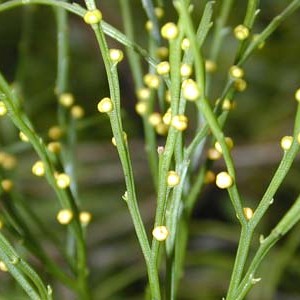Epiphytic or terrestrial homosporous plants with a dichotomously branched, non-photosynthetic rhizome system that lacks roots, and an aerial, photosynthetic, protostelic, shoot system that is unbranched or dichotomously branched. Leaves large and expanded or small and scale-like; sporogenous leaves bifid. Sporangia large, fused to form a bilocular or trilocular synangium situated in axils of bifid leaves. Spores numerous, large, bilateral, monolete, yellow. Gametophyte subterranean, mycorrhizal, non-chlorophyllous, fleshy, similar to rhizome. Antheridia and archegonia in zones or uniformly distributed.
Plants perennial, terrestrial or epiphytic, with corallike, rhizoid-bearing, branched, subterranean axes. Roots absent. Aerial shoots simple or dichotomously branched; appendages leaflike or bractlike, alternate to subopposite, veinless or 1-veined, less than 1 cm. Synangia globose, of 2--3 fused, homosporous eusporangia, solitary in axils of shoot appendages, dehiscing loculicidally. Spores many, reniform, not green. Gametophytes subterranean, mycotrophic, fleshy, elongate, and branched.
Terrestrial or epiphytic. Leaves small, simple, scale-like, ovate, spaced, spirally disposed, rigid, somewhat spiniform with distinct or very poorly developed bundles
Aerial stems chlorophyllose, simple or dichotomously branched produced from non-chlorophyllous mycorrhizal rootless rhizome-like horizontal axes
Leaves represented by minute subulate, scale–like, spirally arranged appendages
Stems erect (in W.African species), photosynthetic, green, angular, dichotomous
Epiphytic perennial herbs; rootless with dichotomous mycorrhizal rhizomes

